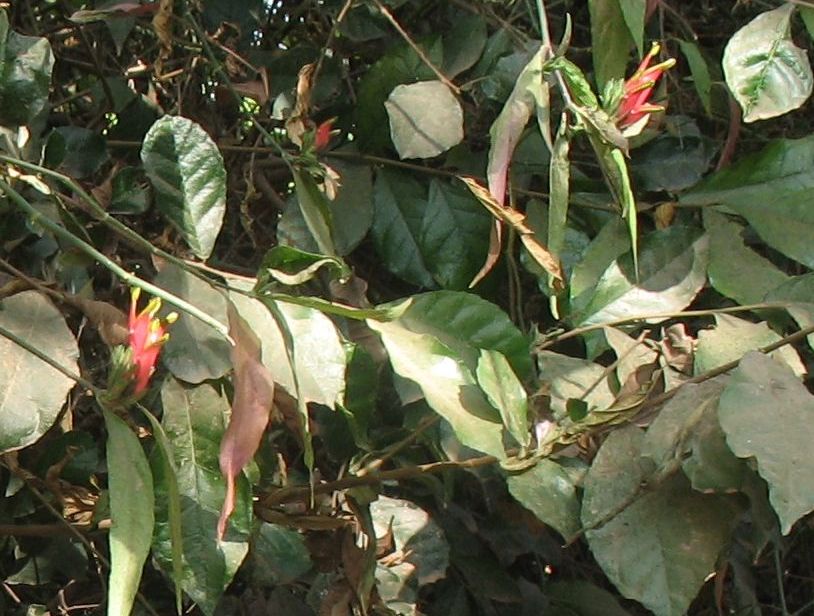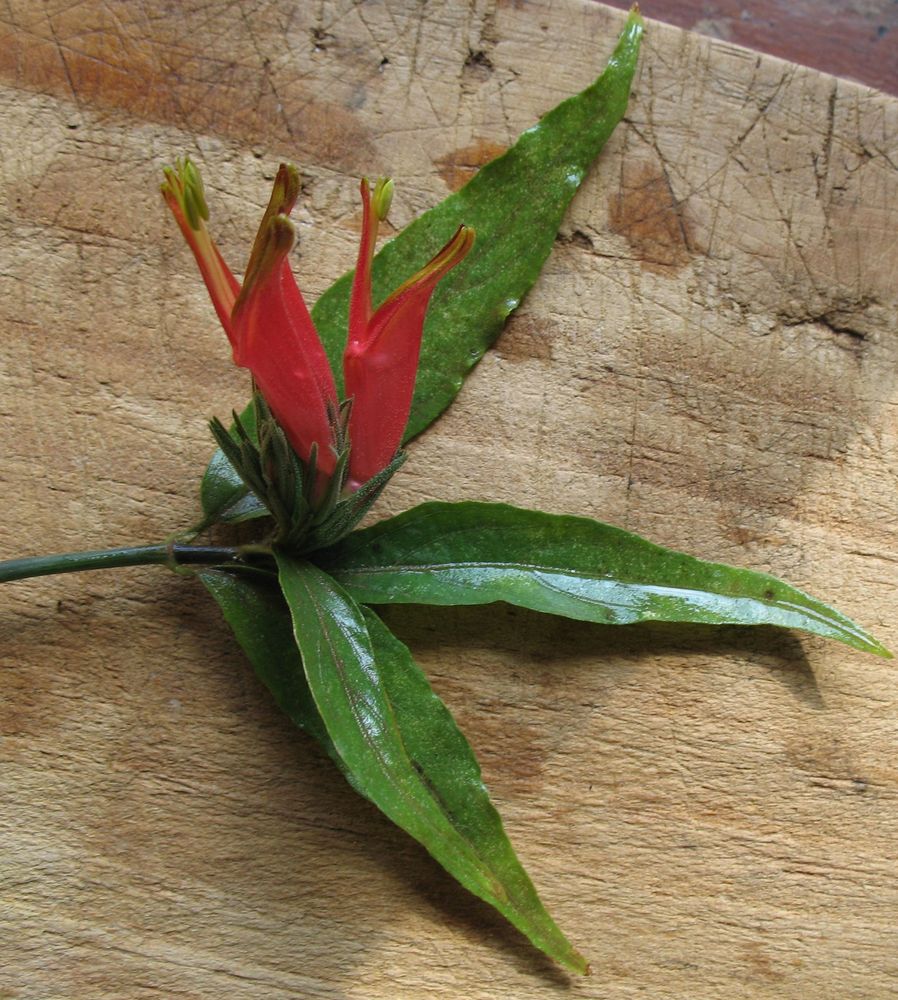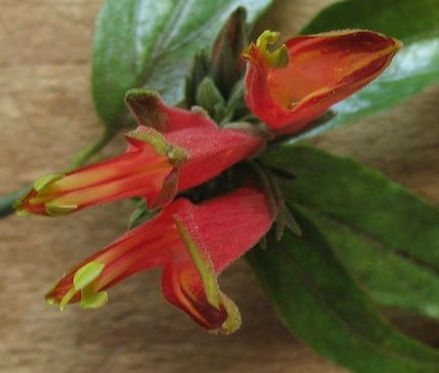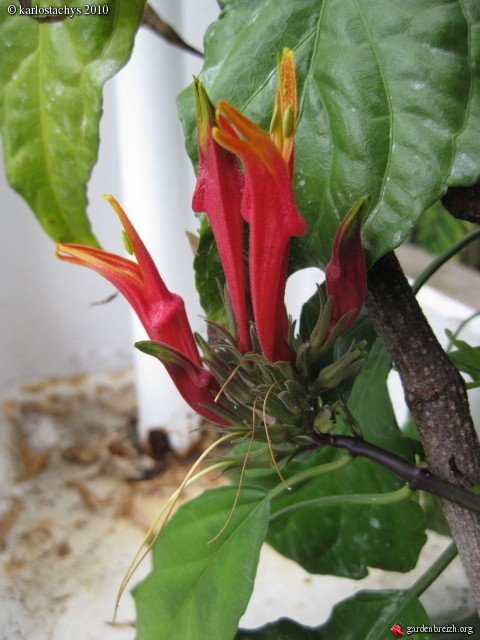Sabah Snake Grass is rare in Laos and yet this plant is native to the Indo-Malaysian region. It is a climber that forms bushes up to a height of 2 or 3 meters. Its stems are round and green at first, then grey. Its leaves are simple, opposite, lanceolate, and dark green. The inflorescences at the end of the branch are composed of green interlocking bracts from which emerge red flowers; they are tubular, with two yellow-edged lips on which stand out two green stamens; this mixture of green, red and yellow is the most beautiful effect. The fruit is a capsule containing small seeds.
In Laos, we have photographed this plant in an abandoned land and it does not seem to interest people much, whereas in Thailand it is famous as a traditional and modern medicinal plant. Its Lao name evokes the mongoose (phangphon), a sworn enemy of snakes; in English, this snake grass is said to be from Sabah (in Malaysia).
In fact, the main use of Clinacanthus in traditional medicine, recommended by the ITM, is the treatment of snake bites, scolopendra and scorpions; the leaves and root, crushed, are applied as a poultice to injured skin to reduce inflammation. This usage is found in India and Malaysia. A less traditional use recommends the plant to fight against herpes and in general against skin irritations; ointments are sold in Thailand for this purpose. Numerous studies show a significant reduction in skin lesions thanks to Clinacanthus nutans. However, The Critical Guide to Alternative Medicine considers that “the arguments (in favour of Clinacanthus.) are promising but their weight is insufficient to allow supported recommendations”. This does not prevent several charlatans from the offering, on the internet, in particular, teas or creams based on Clinacanthus to even treat breast cancer.
L’herbe aux serpents est rare au Laos et pourtant cette plante est originaire de la région indo malaise. C’est une grimpante qui forme des buissons jusqu’à une hauteur de 2 ou 3 mètres. Ses tiges sont rondes et vertes d’abord, grises ensuite. Ses feuilles sont simples, opposées, lancéolées, vert foncé. Les inflorescences en bout de branche sont composées de bractées imbriquées vertes d’où sortent des fleurs rouges; elles sont tubulaires, à deux lèvres bordées de jaune sur lesquelles se détachent deux étamines vertes; ce mélange de vert, rouge et jaune est du plus bel effet. Le fruit est une capsule contenant des petites graines.
Au Laos nous avons photographié cette plante dans des terrains abandonnés et elle ne semble pas beaucoup intéresser les gens, alors qu’en Thaïlande, elle est réputée comme plante médicinale traditionnelle et moderne. Son nom lao évoque la mangouste (phangphom), ennemi juré des serpents; en anglais cette herbe aux serpents est dite de Sabah (en Malaisie).
En effet le principal emploi de Clinacanthus en médecine traditionnelle, recommandé par l’IMT, est le soin des morsures de serpents, de scolopendre et de scorpion; les feuilles et la racine, écrasées, sont appliquées en cataplasme sur la peau blessée pour diminuer l’inflammation. Cet usage se retrouve en Inde et en Malaisie. Un usage moins traditionnel recommande la plante pour lutter contre l’herpès et en général contre les irritations cutanées; des pommades sont vendues en Thaïlande à cet effet. De nombreuses études montrent une réduction significative des lésions cutanées grâce à Clinacanthus nutans. Cependant Le Guide critique des médecines alternatives considère que « les arguments (en faveur de Clinacanthus.) sont prometteurs mais leur poids insuffisant pour permettre des recommandations appuyées ». Ce qui n’empêche pas un certain nombre de charlatans de proposer, sur internet en particulier, des thés ou des crèmes à base de Clinacanthus pour soigner même le cancer du sein.




Sabah Snake Grass is rare in Laos and yet this plant is native to the Indo-Malaysian region. It is a climber that forms bushes up to a height of 2 or 3 meters. Its stems are round and green at first, then grey. Its leaves are simple, opposite, lanceolate, and dark green. The inflorescences at the end of the branch are composed of green interlocking bracts from which emerge red flowers; they are tubular, with two yellow-edged lips on which stand out two green stamens; this mixture of green, red and yellow is the most beautiful effect. The fruit is a capsule containing small seeds.
In Laos, we have photographed this plant in an abandoned land and it does not seem to interest people much, whereas in Thailand it is famous as a traditional and modern medicinal plant. Its Lao name evokes the mongoose (phangphon), a sworn enemy of snakes; in English, this snake grass is said to be from Sabah (in Malaysia).
In fact, the main use of Clinacanthus in traditional medicine, recommended by the ITM, is the treatment of snake bites, scolopendra and scorpions; the leaves and root, crushed, are applied as a poultice to injured skin to reduce inflammation. This usage is found in India and Malaysia. A less traditional use recommends the plant to fight against herpes and in general against skin irritations; ointments are sold in Thailand for this purpose. Numerous studies show a significant reduction in skin lesions thanks to Clinacanthus nutans. However, The Critical Guide to Alternative Medicine considers that “the arguments (in favour of Clinacanthus.) are promising but their weight is insufficient to allow supported recommendations”. This does not prevent several charlatans from the offering, on the internet, in particular, teas or creams based on Clinacanthus to even treat breast cancer.
L’herbe aux serpents est rare au Laos et pourtant cette plante est originaire de la région indo malaise. C’est une grimpante qui forme des buissons jusqu’à une hauteur de 2 ou 3 mètres. Ses tiges sont rondes et vertes d’abord, grises ensuite. Ses feuilles sont simples, opposées, lancéolées, vert foncé. Les inflorescences en bout de branche sont composées de bractées imbriquées vertes d’où sortent des fleurs rouges; elles sont tubulaires, à deux lèvres bordées de jaune sur lesquelles se détachent deux étamines vertes; ce mélange de vert, rouge et jaune est du plus bel effet. Le fruit est une capsule contenant des petites graines.
Au Laos nous avons photographié cette plante dans des terrains abandonnés et elle ne semble pas beaucoup intéresser les gens, alors qu’en Thaïlande, elle est réputée comme plante médicinale traditionnelle et moderne. Son nom lao évoque la mangouste (phangphom), ennemi juré des serpents; en anglais cette herbe aux serpents est dite de Sabah (en Malaisie).
En effet le principal emploi de Clinacanthus en médecine traditionnelle, recommandé par l’IMT, est le soin des morsures de serpents, de scolopendre et de scorpion; les feuilles et la racine, écrasées, sont appliquées en cataplasme sur la peau blessée pour diminuer l’inflammation. Cet usage se retrouve en Inde et en Malaisie. Un usage moins traditionnel recommande la plante pour lutter contre l’herpès et en général contre les irritations cutanées; des pommades sont vendues en Thaïlande à cet effet. De nombreuses études montrent une réduction significative des lésions cutanées grâce à Clinacanthus nutans. Cependant Le Guide critique des médecines alternatives considère que « les arguments (en faveur de Clinacanthus.) sont prometteurs mais leur poids insuffisant pour permettre des recommandations appuyées ». Ce qui n’empêche pas un certain nombre de charlatans de proposer, sur internet en particulier, des thés ou des crèmes à base de Clinacanthus pour soigner même le cancer du sein.








Sabah Snake Grass is rare in Laos and yet this plant is native to the Indo-Malaysian region. It is a climber that forms bushes up to a height of 2 or 3 meters. Its stems are round and green at first, then grey. Its leaves are simple, opposite, lanceolate, and dark green. The inflorescences at the end of the branch are composed of green interlocking bracts from which emerge red flowers; they are tubular, with two yellow-edged lips on which stand out two green stamens; this mixture of green, red and yellow is the most beautiful effect. The fruit is a capsule containing small seeds.
In Laos, we have photographed this plant in an abandoned land and it does not seem to interest people much, whereas in Thailand it is famous as a traditional and modern medicinal plant. Its Lao name evokes the mongoose (phangphon), a sworn enemy of snakes; in English, this snake grass is said to be from Sabah (in Malaysia).
In fact, the main use of Clinacanthus in traditional medicine, recommended by the ITM, is the treatment of snake bites, scolopendra and scorpions; the leaves and root, crushed, are applied as a poultice to injured skin to reduce inflammation. This usage is found in India and Malaysia. A less traditional use recommends the plant to fight against herpes and in general against skin irritations; ointments are sold in Thailand for this purpose. Numerous studies show a significant reduction in skin lesions thanks to Clinacanthus nutans. However, The Critical Guide to Alternative Medicine considers that “the arguments (in favour of Clinacanthus.) are promising but their weight is insufficient to allow supported recommendations”. This does not prevent several charlatans from the offering, on the internet, in particular, teas or creams based on Clinacanthus to even treat breast cancer.
L’herbe aux serpents est rare au Laos et pourtant cette plante est originaire de la région indo malaise. C’est une grimpante qui forme des buissons jusqu’à une hauteur de 2 ou 3 mètres. Ses tiges sont rondes et vertes d’abord, grises ensuite. Ses feuilles sont simples, opposées, lancéolées, vert foncé. Les inflorescences en bout de branche sont composées de bractées imbriquées vertes d’où sortent des fleurs rouges; elles sont tubulaires, à deux lèvres bordées de jaune sur lesquelles se détachent deux étamines vertes; ce mélange de vert, rouge et jaune est du plus bel effet. Le fruit est une capsule contenant des petites graines.
Au Laos nous avons photographié cette plante dans des terrains abandonnés et elle ne semble pas beaucoup intéresser les gens, alors qu’en Thaïlande, elle est réputée comme plante médicinale traditionnelle et moderne. Son nom lao évoque la mangouste (phangphom), ennemi juré des serpents; en anglais cette herbe aux serpents est dite de Sabah (en Malaisie).
En effet le principal emploi de Clinacanthus en médecine traditionnelle, recommandé par l’IMT, est le soin des morsures de serpents, de scolopendre et de scorpion; les feuilles et la racine, écrasées, sont appliquées en cataplasme sur la peau blessée pour diminuer l’inflammation. Cet usage se retrouve en Inde et en Malaisie. Un usage moins traditionnel recommande la plante pour lutter contre l’herpès et en général contre les irritations cutanées; des pommades sont vendues en Thaïlande à cet effet. De nombreuses études montrent une réduction significative des lésions cutanées grâce à Clinacanthus nutans. Cependant Le Guide critique des médecines alternatives considère que « les arguments (en faveur de Clinacanthus.) sont prometteurs mais leur poids insuffisant pour permettre des recommandations appuyées ». Ce qui n’empêche pas un certain nombre de charlatans de proposer, sur internet en particulier, des thés ou des crèmes à base de Clinacanthus pour soigner même le cancer du sein.


